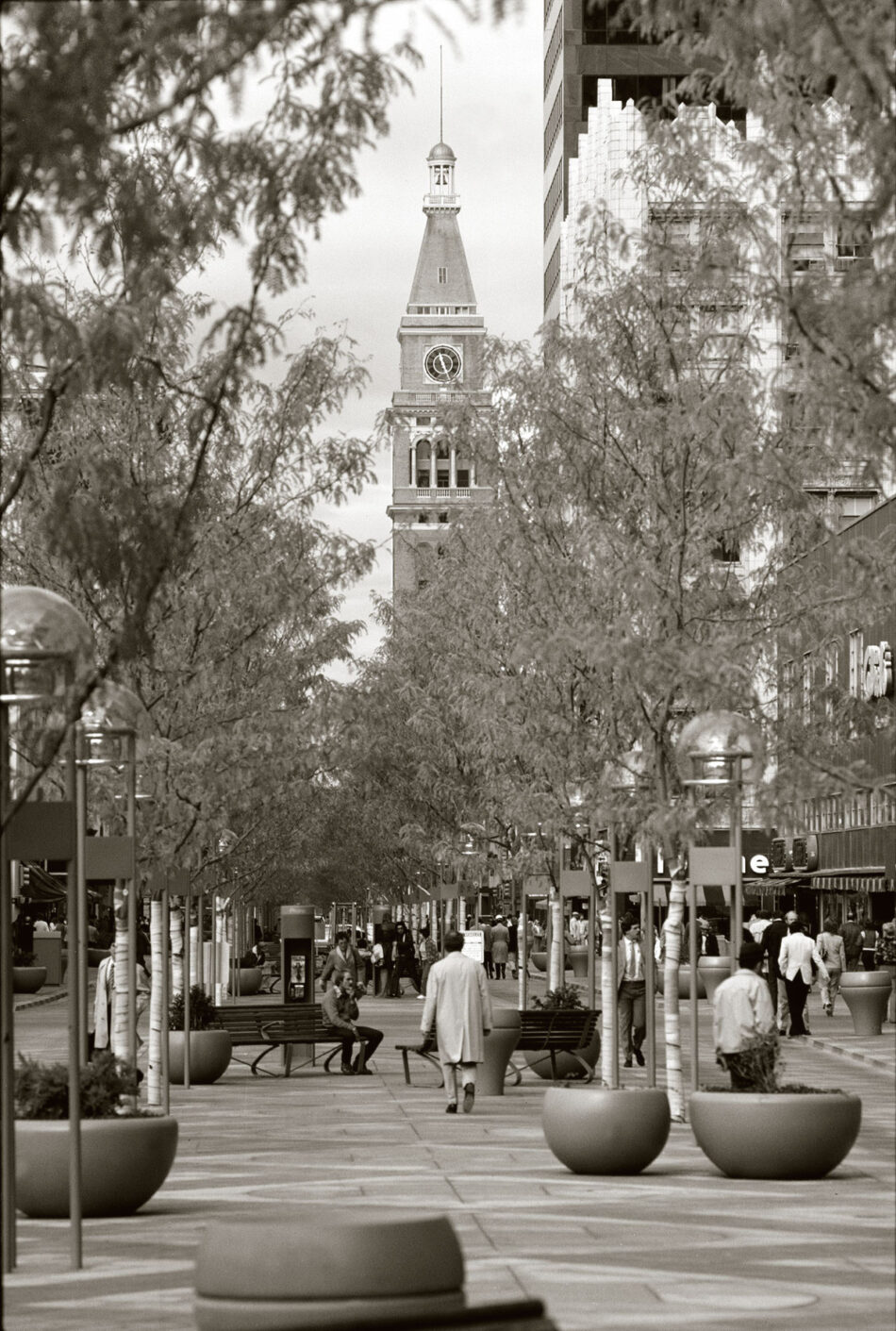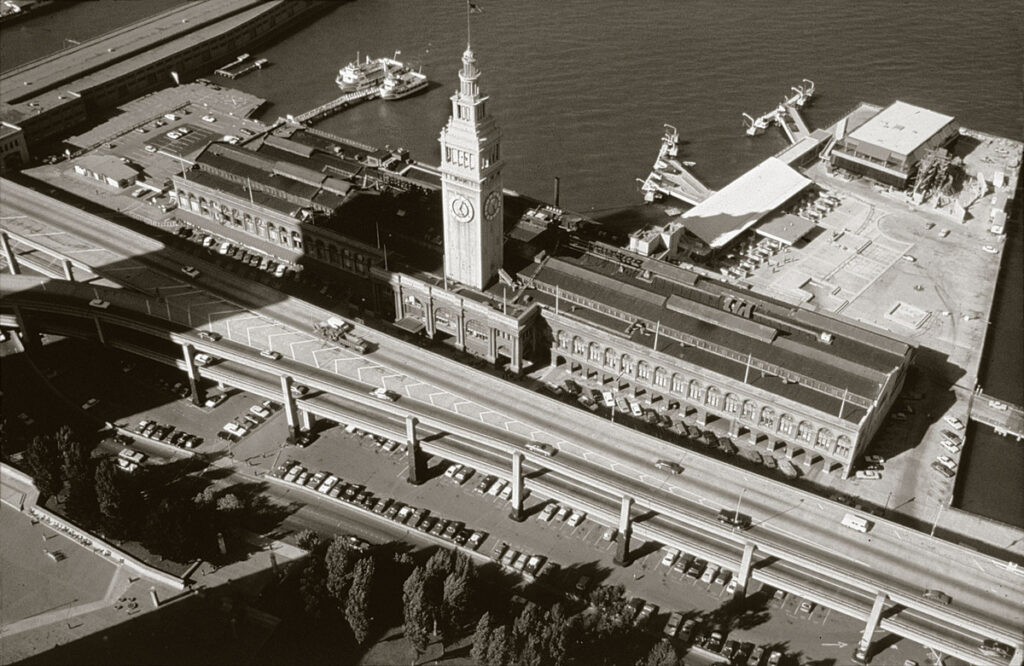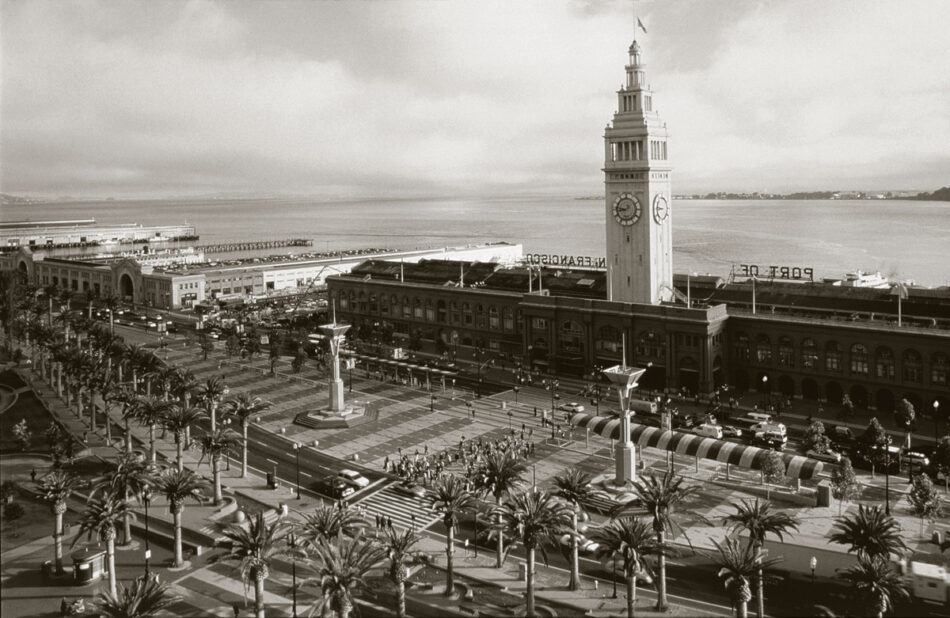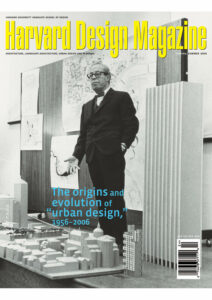The Way We Were, the Way We Are: The Theory and Practice of Designing Cities since 1956
What is the designed city, who wants to make it happen, and who designs it?
Today most urban design professionals would say that a well-designed city has three components: it conserves the natural environment and is responsive to it; it creates a desirable public realm that includes transportation, streets, civic spaces, shopping, entertainment, parks, and recreation; and it supports social interaction in residential neighborhoods, work places, and mixed-use downtowns.
The three major political constituencies for implementing urban design concepts are environmentalists who want to shape development to conserve the natural world and preserve its systems, civic promoters who seek to distinguish their city from its competition by its higher quality urban and civic life, and community activists who want to preserve and restore the places where they live and who want new development to have the good qualities of traditional neighborhoods.
Cities today are designed by an intricate interplay of private investment, public subsidies and incentives for development, government regulations, public participation, and public protest. The professional urban designer needs to know how to work with and guide all these forces. Landscape architecture, architecture, and city planning each relate most directly to one of the constituencies for urban design. The urban designer is likely to have a professional credential in one of these disciplines and needs to be conversant with all three. But how does the designer get a seat at the table when the decisions are being made?

Urban Design and the Natural Environment
In 1956, Ian McHarg, a recent Harvard graduate in both city planning and landscape architecture, was teaching at the University of Pennsylvania. The next year he was to begin his course, Man and the Environment, which led to a television program, The House We Live In, and ultimately to his 1969 book, Design with Nature. McHarg saw the natural environment as the equivalent of a design, the resolution into equilibrium of such elements as geologic forms, rain and flood-water, soil conditions, vegetation, and animal habitat. Ignorant interventions that disturb natural systems lead to incalculable consequences, many times adverse. Once you understand McHarg’s thesis, you see why summer houses built on dunes will wash away in hurricanes, why whole streets of houses in landslide-prone Los Angeles are fated to subside into valleys, and why Houston becomes more and more subject to flooding.
The failure to relate the natural environment to urban design is a conspicuous blind spot in most of the Harvard Urban Design Conference proceedings. Richard Neutra provided an interesting exception when he said: “The urban landscape which we want to improve by our artifacts is in the first place a phenomenon to be understood on a biological basis,”3 a statement that also includes Anne Spirn’s extension of McHarg’s philosophy to the existing city in The Granite Garden: Urban Nature and Human Design.4 (Spirn was McHarg’s pupil of at the University of Pennsylvania and was once head of Harvard’s Landscape Architecture Department.) McHarg helped define the need for today’s geographic information systems (GIS) which replace with “layers” on a computer the overlays on tracing paper, painstakingly researched and redrawn to the same scale by hand, which made up McHarg’s analyses of the most appropriate locations to build within the natural landscape.
Today GIS and the spatial analytics that they make possible are powerful tools that enable an urban designer to understand and describe natural systems at a variety of scales and to demonstrate with maps the interactions between development alternatives and natural systems. These demonstrations of the future impacts of different development scenarios can be shown interactively in real time at public meetings, giving the public a means of making informed comments on long-range regional design decisions like the selection of highway routes. This is one way that today’s urban designer can gain a seat at the decision-making table.
Urban Design as a Civic Vision
“The sponsors have avoided the term Civic Design as having, in the minds of many, too specialized or too grandiose a connotation,” reads the introduction to the 1956 conference summary in Progressive Architecture. “Urban Design” was the name that the Harvard Graduate School of Design selected for its 1956 conference and for the “joint work of the architect, landscape architect, and city planner.” By explicitly discarding the term civic design, the sponsors were disavowing the City Beautiful with its park and boulevard plans repeating formulations worked out in Haussmann’s Paris and the World’s Columbian Exposition in Chicago (“too grandiose”), and its emphasis on public buildings grouped in a civic center (“too specialized”). Defining urban design as collaboration among professionals, rather than as a series of specific design objectives, reflected the then current thinking in the city planning profession, which was giving up on end-state plans and redefining planning as a continuous process.
Partly because of the 1956 Harvard conference, urban design has become the accepted term; it is too late to wonder about changing it. Many present problems in implementing city designs were described by the conference participants, but the conference also helped formulate urban design in a way that has itself contributed to current difficulties in creating coherent, well-designed cities. Discarding the word civic marked a significant change in city design priorities. The illustrations that accompany the summary of the conference express utility and perhaps social equality, but aside from the diagrams of Radburn and Welwyn Garden City, there is little in these drawings to connote more complex societal aspirations.
While the design vocabulary for civic design in the United States was drawn from palatial European examples, Americans had never accepted such designs as if they were creating a place to watch the royal coach roll down the boulevard on the way to a state occasion. The Chicago Fair of 1893 was a populist fun-fest; Grand Central and Pennsylvania Stations glorified mass transit; impressive museums and libraries were open to everyone, as were the great civic parks in almost every city. However, Hitler’s and Stalin’s use of the classical design vocabulary established for many people that not only might such designs not be appropriate to the modern era but also that they were the language of oppression. It is understandable why the sponsors of the conference wanted to distance themselves from classical architecture, which had been renounced at Harvard for almost twenty years; the problem is that they confused it with civic design. There is still confusion about this today.

Not acknowledging the civic component of urbanism turns sidewalks and public spaces into utilitarian places between buildings, providing little more than light and air, and passages for pedestrians. Most urban plazas of the last fifty years provide good views of the buildings they front but are devoid of social significance. The research of Jan Gehl and William H. Whyte, among others, has helped establish how people use public space, and that in turn has helped show designers how to configure and furnish sidewalks and public places so that they will be used and thus regain significance in community life. Other lessons for the design of civic space have come from the devices retailers use to attract people to shopping precincts. “Place-making” has become a slogan of modern-day retailing. With retailers saying, “Hey, this stuff really works,” civic spaces have again become important in city design as a means of attracting people to the city and of keeping them there. Urban designers are now in demand to provide the inspiration for such places.
Defining civic spaces with groups of buildings designed by different architects at unpredictable intervals over a long period of time is a central task for the urban designer. As designers have rediscovered the importance of civic spaces, they have also discovered the devices used in the past to pull such places together: the guidelines of Baron Haussmann in Paris, those for the Back Bay in Boston, and the more abstract, form-based street walls and setbacks of New York City’s original 1916 zoning code. These elements of civic design derive from the classical tradition, but they are abstract enough to be incorporated into zoning codes. Zoning codes always determine city form, but the modern codes that came into use in the 1960s introduced floor area ratios as the basic bulk control, making the shape of buildings an often unanticipated by-product. Writing the preferred location and shape of buildings into codes makes them a major tool for realizing urban design concepts. Beginning with New York City’s special zoning districts in the 1960s, the design guidelines for Battery Park City in the late 1970s, and the “regulating plans” used at Seaside and other master-planned communities in the 1980s, “form-based coding” is now finding its way into zoning ordinances in such places as Louisville, Nashville, Miami-Dade County, and St. Paul.
Using zoning to implement urban design was discussed by Frederick Adams at the Harvard conference, but he assumed that requiring good design meant wide administrative discretion, and he expressed himself as doubtful that public officials would ever be permitted to exercise this kind of subjective control. Adams’s skepticism was justified, but he underestimated the ability of designers to identify the salient characteristics of good civic design and express them in ways compatible with zoning. Writing and administering codes is becoming another way for designers to gain a seat at the decision-making table.
Urban Design to Support Social Interaction
Neighborhood planning, as defined by Clarence Perry and others in the 1920s and 1930s, was rediscovered first in the 1960s as an antidote to urban renewal or, to repeat the Lewis Mumford quotation, “the absolute folly of creating a physical structure at the price of destroying the intimate social structure of a community’s life.” Once planners and architects started listening to communities and planning with them, they began designing buildings and spaces to fit into existing neighborhoods rather than replace them. Neighborhood planning was rediscovered again in the 1980s as an antidote to large tracts of suburban houses, all the same size on the same-sized lots, completely segregated from stores and work places. The creation in newly developed areas of compact, walkable neighborhoods with a mix of different house-types and some stores and civic buildings replicates traditional patterns in cities and suburbs before the Second World War. Some designers are also attempting to replicate pre-Second World War neighborhood architecture (no architectural historian would be fooled for a minute), but doing so is not necessary to the concept of neighborhood design and is likely to be a transitional phase. Helping developers create new places friendly to the social interactions that make up a neighborhood and helping cities preserve and restore older neighborhoods and historic districts have turned out to be major activities for urban designers, another place where design has become a significant part of the decisions that shape urban and suburban development.
The sponsors and participants of the Harvard conference undoubtedly agreed on the importance of neighborhoods, a principle accepted by CIAM and seen in the work of even such an iconoclast as Le Corbusier. But the speakers, including Jane Jacobs, don’t seem to have perceived the neighborhood as an element shared by city and suburb, and thus a basic unit of the multi-centered modern metropolis. Instead they described city and suburb as at war with each other, and the suburb as the city gone wrong.
When they spoke, Jean Gottmann was beginning the research that he published in 1961 as Megalopolis, a book that demonstrated that formerly separate cities were growing together into conglomerations that extended over big geographic areas. He helped change everyone’s understanding of the modern city. In 1956 downtowns were still found only in the historic centers of big cities or suburban towns. Today a mixed-use town center is a real estate concept that might be attempted in many kinds of places. Office buildings and other urban elements that used to be found exclusively downtown can be scattered over the landscape, forming what have been called “edgeless cities.” Today’s city is a complex metropolitan organism still in the process of formation, and guiding its development is the principal challenge for urban designers.

José Luis Sert and most of the speakers at Harvard in 1956 would be pleased to see that today hundreds of architecture, landscape architecture, and planning firms offer urban design services as a significant part of their professional practice and that many urban design concepts have actually been implemented. However, they would look at today’s rapidly urbanizing world and tell us that there has also been a big increase in the kinds of problems urban designers need to solve. Experts tell us that the world’s population will have stabilized at about ten billion people in the next fifty years. If we are spared world-wide war, famine, and plague, the correctives for over-population that the Reverend Thomas Malthus predicted, perhaps people will then be able to perfect the built environment and its relationship to nature. Let us hope that there will be a collection of essays like this one published fifty years from now.
“The action of the Congress of the United States in appropriating one billion dollars to create a new urban environment places on all of us a responsibility we cannot duck.”1 So Edmund Bacon began his remarks at the Harvard Urban Design Conference in 1956, provoking our reflections on the history of urban renewal, on the smaller value of a billion dollars in today’s money, and on the current lack of any such Congressional commitment. Not having Federal subsidies to help cities buy land and buildings makes a big difference in the design of cities today. The flow of Federal money is the presence behind much of the discourse at the 1956 Harvard Conference about the directive role of the urban designer. In the 1950s, developers and elected local officials could be expected to pay attention to urban renewal administrators, housing authority directors, and the heads of city planning departments—and by extension the designers who worked for them—when they could unlock subsidies from Washington and help determine how they were spent. Once cities have to depend more on their own resources, the city design problem becomes one of managing the cumulative effect of everyday decisions about zoning, housing subsidies, and public works. The planning and urban renewal directors revert to being administrators rather than initiators, and the role of initiator belongs mainly to the state transportation departments—the de facto planners of today’s regional cities — and to private real estate investors.
The 1956 conference sponsors were right to define urban design as a collaborative process, but less right to define it as a collaborative process among architects, planners, and landscape architects. What are the roles of the engineer, the real estate investor, and the elected public official? And what about the public itself? Jane Jacobs was present at Harvard in 1956 and had some cogent criticisms of the kinds of abstract, geometric urban designs, mostly urban renewal proposals, that were on exhibit and that illustrate the report on the conference. Interestingly, Lewis Mumford, who was to have a sharp public quarrel with Jane Jacobs when her critique of planning and urban renewal, The Death and Life of Great American Cities, was published five years later, agreed with her completely at Harvard: “If this conference does nothing else, it can at least [lead its participants to] go home and report on the absolute folly of creating a physical structure at the price of destroying the intimate social structure of a community’s life.”2
